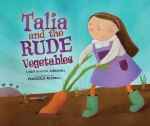 Stories can be powerful, accessible ways for children to understand people different than themselves. Stories can also show that people share universal traits in common, like the desire to be happy, healthy and part of a family. Nathan Blows Out the Hanukkah Candles is a book that will connect readers with a young autistic character.
Stories can be powerful, accessible ways for children to understand people different than themselves. Stories can also show that people share universal traits in common, like the desire to be happy, healthy and part of a family. Nathan Blows Out the Hanukkah Candles is a book that will connect readers with a young autistic character.
Kar-Ben author Tami Lehman-Wilzig lived for a year in Providence, where she met local PJ Library director, Nicole Katzman. Tami introduced Nicole to her books and Nicole, the mother of four young children (one of whom is autistic) and a fierce campaigner for autistic children's rights, told Tami about her determination to have a book on an autistic child written for the American Jewish community. It didn't take long for the two to pair up and develop Kar-Ben's new book Nathan Blows Out the Hanukkah Candles. Read the authors’ exchange about their story:
Nicole: Accepting the other in our midst is an important Jewish value. As a mother of an autistic child I didn't feel that acceptance. All too often I found the situation to be reverse and at times painful. I knew that in order to help children understand how to accept the other they needed a story to which they could relate.
Tami: I understood Nicole's feeling of urgency. One of my sons has special needs and I remembered how difficult it was for him as a child. In addition, there were autistic twins in our neighborhood while our sons were growing up, so I was already familiar with autistic behavior. For example, they would continually repeat the same question or statement, but we needed more than behavioral differences. We needed a peg around which we could develop a compelling story.
Nicole: At first I tried writing a story, but it didn't work. After reading it, Tami decided that she had to “interview” me. So I told her all about our son Nathan. She kept prodding me with questions. Finally, she said 'give me an example of something Nathan did that got you really upset.'
Tami: The minute Nicole related the incident of Nathan blowing out the Hanukkah candles the previous year, I knew we had the peg. It was perfect. Nathan's action was off the chart and Hanukkah was a wonderful setting. Creating a story around it with the right feel was the challenge. I wanted the story to be true – not too sugary, but not too tough. Finding the right balance was a challenge and it took several drafts, plus the help of “book doctor” Deborah Brodie to put me on the right track. It was Deborah who suggested that I tell the story from a sibling's vantage point. The minute I did that, everything fell into place. Since I was already familiar with the repetitive nature of autistic children's conversations, I used that particular quirk to jump start the story. I consulted with Nicole throughout the entire writing process to make sure that Nathan's behavior was on track, as well as the reactions of siblings and kids.
Nicole: It's exciting for me to have a book on an autistic child that is specifically my son. It's more than a dream come true. It's an opportunity to open people's eyes and minds. Too often they are misinformed about autism, insensitive in their comments and judgmental of both the child and his/her caregivers.
Tami: I am so pleased that Nicole inspired me to write this book. Both of us feel that Nathan Blows Out the Hanukkah Candles will make an important contribution to the Jewish community by being read aloud in the classroom or at home, and then used to open a conversation on how to love, respect and understand children who are different.
Nicole: Do you have a child with autism, or a friend or relative? If you have a story of your own please share it with us. Help us break down the barriers.
Please add your voice to Tami and Nicole’s initiative to create more understanding about autism. Please post your own comments, story or insights about autism below.
 In a recent essay in the Albany Times Union, Kar-Ben author Linda Elovitz Marshall writes about the power of words and their ability to create conflict or bring understanding. Marshall’s most recent book Talia and the Rude Vegetables, plays with language as the young protagonist mishears her grandmother ask her to gather root vegetables from the garden for a Rosh Hashanah stew. Marshall writes:
In a recent essay in the Albany Times Union, Kar-Ben author Linda Elovitz Marshall writes about the power of words and their ability to create conflict or bring understanding. Marshall’s most recent book Talia and the Rude Vegetables, plays with language as the young protagonist mishears her grandmother ask her to gather root vegetables from the garden for a Rosh Hashanah stew. Marshall writes:






